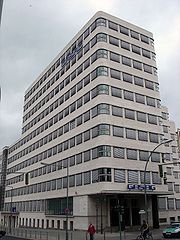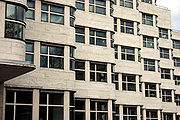
Shell-Haus
Encyclopedia



Landwehrkanal
The Landwehr Canal, or Landwehrkanal in German, is a long canal parallel to the Spree river in Berlin, Germany, built between 1845 and 1850 according to plans by Peter Joseph Lenné...
in the Tiergarten
Tiergarten
Tiergarten is a locality within the borough of Mitte, in central Berlin . Notable for the great and homonymous urban park, before German reunification, it was a part of West Berlin...
district of Berlin
Berlin
Berlin is the capital city of Germany and is one of the 16 states of Germany. With a population of 3.45 million people, Berlin is Germany's largest city. It is the second most populous city proper and the seventh most populous urban area in the European Union...
.
Building and design
In 1929 a competition was held between five architects to determine the designer of a prestigious new office block to house the headquarters of the mineral oil company, and ShellRoyal Dutch Shell
Royal Dutch Shell plc , commonly known as Shell, is a global oil and gas company headquartered in The Hague, Netherlands and with its registered office in London, United Kingdom. It is the fifth-largest company in the world according to a composite measure by Forbes magazine and one of the six...
subsidiary, Rhenania-Ossag. The victor was the German architect and professor Emil Fahrenkamp
Emil Fahrenkamp
Emil Fahrenkamp was a German architect and professor, one of the most prominent architects of the interwar period, best known for his 1930 Shell-Haus in Berlin....
(1885-1966).
After almost two years in construction, Shell-Haus opened in 1932. At the time the building was noted for its modernist design, for its striking wave-like façade, and for being one of the first steel-framed high-rise buildings in Berlin. In retrospect it is regarded as Fahrenkamp’s masterpiece and one of the most significant office block designs of the Weimar Republic.
Shell-Haus’ simplistic graceful forms are stylistically reminiscent of the German modern realist movement New Objectivity
New Objectivity (architecture)
The New Objectivity is a name often given to the Modern architecture that emerged in Europe, primarily German-speaking Europe, in the 1920s and 30s. It is also frequently called Neues Bauen...
, but Fahrenkamp also incorporated more traditional aspects to his design.
The most eye-catching feature of Shell-Haus is its main façade, which jumps forward in six gentle waves whilst at the same time increasing in height from six levels (five at the back) to ten. The building itself comprises four wings situated around a four-sided inner courtyard.
A turbulent history
During the Second World War Shell-Haus was used by the naval high command and the cellars were converted into a makeshift hospital.Despite the upper floors being damaged in the Battle of Berlin
Battle of Berlin
The Battle of Berlin, designated the Berlin Strategic Offensive Operation by the Soviet Union, was the final major offensive of the European Theatre of World War II....
at the close of the war, Shell-Haus was one of Berlin’s few great edifices to survive the widespread destruction of the city relatively unscathed.
After clearing away the war damage, in 1946 the Berlin electricity board BEWAG made Shell-Haus its head office.
In 1958 Shell-Haus was put under the protection of historical monuments. However this acknowledgement of its architectural importance did not save the building from its post-war dilapidation, and it remained in a degraded state for many years to follow.
Between 1965 and 1967, the Shell-Haus site was extended northwards with the construction of two similarly steel-framed buildings designed by the German architect Paul Baumgarten. Being comparatively conventional and unremarkable in design, they were not included under the original building’s historical monument protection and an 1995 application to rectify this was quashed.
The long overdue renovation
When in the 1980s, talk turned to the long overdue restoration of Shell-Haus a dispute over the funds needed ensued and continued into the mid-1990s. Renovation work was carried out on the courtyard façade in the early eighties but this failed to meet the required standards.In 1995 Bewag moved out of Shell-Haus in readiness for the overdue renovation project. And so in 1997, after 13 years of unrest, the restoration work began. At the time the total costs were estimated at around 50 million deutschmarks. but by the time work was completed in February 2000, the expenditure had escalated to around 80 million marks. A major contributory factor to this was the need to reopen the quarry Longarina of the company CIMEP in Tivoli
Tivoli, Italy
Tivoli , the classical Tibur, is an ancient Italian town in Lazio, about 30 km east-north-east of Rome, at the falls of the Aniene river where it issues from the Sabine hills...
near Rome
Rome
Rome is the capital of Italy and the country's largest and most populated city and comune, with over 2.7 million residents in . The city is located in the central-western portion of the Italian Peninsula, on the Tiber River within the Lazio region of Italy.Rome's history spans two and a half...
in order to supply the travertine
Travertine
Travertine is a form of limestone deposited by mineral springs, especially hot springs. Travertine often has a fibrous or concentric appearance and exists in white, tan, and cream-colored varieties. It is formed by a process of rapid precipitation of calcium carbonate, often at the mouth of a hot...
rock for the building façade.
The pain-staking detail and expenditure vested in Shell-Haus did not go unrewarded - the year 2000 saw the renovation work awarded the monument preservation prize, the Ferdinand-von-Quast medal.
In March 2000, the new owner of Shell-Haus, the Berlin energy supplier GASAG, moved in.
High profile admirers
Shell-Haus has several high profile fans including the acclaimed German film director Wim WendersWim Wenders
Ernst Wilhelm "Wim" Wenders is a German film director, playwright, author, photographer and producer.-Early life:Wenders was born in Düsseldorf. He graduated from high school in Oberhausen in the Ruhr area. He then studied medicine and philosophy in Freiburg and Düsseldorf...
– who featured the building in his 1970 debut Summer in the City
Summer in the City (film)
Summer in the City is the first full-length feature film by director Wim Wenders, released in 1970 and starring Hanns Zischler.Wenders' first full-length film was produced as his graduation project at the Academy of Film and Television in Munich which he attended from 1967 to 1970...
- and the architect Meinhard von Gerkan, who said that for him it was the most beautiful building in Berlin
Berlin
Berlin is the capital city of Germany and is one of the 16 states of Germany. With a population of 3.45 million people, Berlin is Germany's largest city. It is the second most populous city proper and the seventh most populous urban area in the European Union...
.

